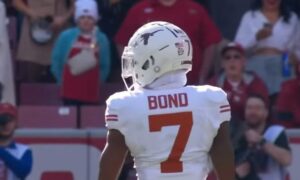The Pittsburgh Steelers premiered the third episode of their “Countdown” series yesterday, which documents the behind the scenes story of the team’s buildup to the 2014 NFL Draft. This episode takes us through to their first-round selection, inside linebacker Ryan Shazier.
Before that, however, Kevin Colbert went into detail about how the team goes about evaluating its prospects. It shouldn’t be difficult to determine from the quote below which trait he places the highest value on in the process:
“I always talk about game—and football—playing. It could be anywhere from 80 to 90 percent of the evaluation, and it should be. We get paid to evaluate players playing the game of football. The Combine information that we gather, it’s like icing on the cake”.
Even though their 15th-overall selection, Shazier, flashed during his workouts leading up to the draft by timing a sub-4.4 in the 40-yard dash, it’s clear that the Steelers scouts highly valued his game tape, and the way that speed translated to the football field, with pads.
The fact that Shazier checked off all the other boxes only cemented their desire to stay put and take him in their original spot—which, as we later found out, was fortunate:
If we have a good player, and he has a great workout, everything’s good. If we have a guy that we really didn’t like and he has a great workout, we’ll double check ourselves to make sure that we didn’t miss something in his play. Most of the time we haven’t; it’s just that he’s a good athlete that may not be a great football player.
So playing the game of football is still paramount in the evaluation. And again, I’d say it’s 80 percent. You factor in 7 to 10 percent for the workout, another 7 to 10 for the character, another 7 to 10 for the medical, and you put it all together, but how they play the game is most important.
As discussed in the second episode, however, it’s not just the tape that is important. It’s how that tape translates to the professional level more generally, and more specifically how that player translates to those with whom he will be playing. Defensive coordinator Dick LeBeau took this to heart when an old coach gave him that advice:
A long time ago a very talented, expert coach—he could evaluate talent—he said, “Dick, never, never grade an athlete down from a workout, an All-Star game. You don’t know—home environment, playing for his team. Talk to the people that coached him there”.
You know as a coach more than anybody the situations you’re going to ask this young man to be involved in. You have a better knowledge of the personality of his teammates that he’s about to join. But you get a chance to get a feel—“oh, I think this guy is a Steeler guy”. And you want to take every avenue that you can explore to see if this guy fits in the Steeler equation.
LeBeau clearly thought that Shazier is a Steeler guy, and not just because they’re both alumni from Ohio State. After Mike Tomlin got on the phone with Shazier and double-checked that he didn’t sprain anything stepping out of the limo earlier that day and informed the player that he would be a Steeler in a few short minutes, LeBeau was eventually handed the phone.
After evidently being prompted by Shazier about how he’s doing, his response was, “I’m smiling, man, how’re you doing?”, which he clearly was.
And in case you were wondering why the Steelers ‘ran to the podium’ to draft him without fielding any trade offers, as the video reveals, the war room fields calls throughout the day. Teams generally know if they have a trade hypothetically in place well before their spot comes up.
But it may not have mattered anyway. Shazier was their guy in that moment. Shazier is their guy now.







